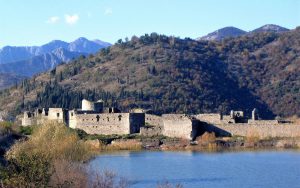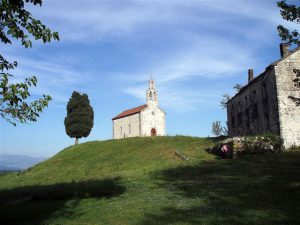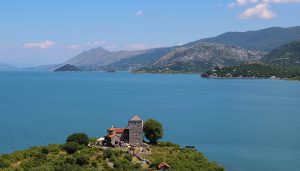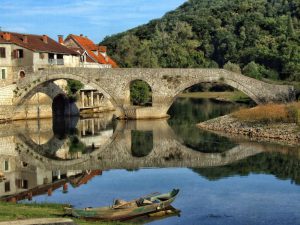Numerous cultural and historical monuments, such as archaeological finds, monasteries and fortifications, scattered in the wide range of the Skadar Lake basin, and numerous islands, say that in the XIV and XV century this area was a significant cultural center.
The cultural and historical heritage of the Skadar Lake consists of:
islands
archaeological sites
monastery complexes,
fortifications,
sacred monuments
ethnographic fund
The cultural and historical importance of the island on Skadar Lake is enormous. On these islands there are many monasteries, churches and sacral monuments. Numerous fortifications on the islands, built by the Turks, and later by the Montenegrins, are witnesses of the frequent fighting that led between these nations. Lesendro’s fortress is an example of the struggle for the struggle of Montenegrins for independence, dates from the 15th century and is known as the capital of Zeta. Also on Skadar Lake there is a Grmozur, where King Nikola built a prison for political non-minded people, known for a long time as Montenegrin Alkatraz. Then there are Starcevo, Beska, Kom, Moracnik and many others from the island.
Grmozur is perhaps the most attractive historical place. The exact date of the imprisonment that King Nicholas built for political unenlightened people is not known. What is known is that they were built by both the Turks and the Montenegrins. Many asked who were actually prisoners on this island. A straightforward answer was that prisoners were chosen for those people who did not know how to swim. They also did not know the guards, in order to prevent any possibility of escaping from the island, i.e. from prison. There is a story that snakes were even ejected in order to kill the prisoners, and that the number of snakes was so great that they had to bring a mongoose on the island to get rid of the snakes. But despite all this, there were those prisoners who managed to escape.
Lesendro – As far as Lesendro’s fortress is concerned, it should be said that it is an extremely important cultural and historical monument. It covers an area of 3,150 m2. As is the case with the Grmozur, i.e. the prison which made the exact date of construction of this fortress on Grmozur is also not known. Lesendro’s fortress was restored in 1832 thanks to Vladika Rade. At that time, this fortress was restored and its walls were lifted much higher after Rasid – pasa from Shkodra accused him of spying and then executed eight men from Crmnica who had come to Shkodra to trade. For eleven years, as Lesendro was under the leadership of the Bishop of Rada, he often stayed there, and according to some sources, he wrote that he wrote some of his great works. In 1843 Osman dogs won Lesendra and Vranjina since they were a little left.
As for the monuments of culture and monastery, they are very numerous in the area of Skadar Lake and they are the representatives of rich Montenegrin history.
Precista Krajinska – One of them is the Precista Krajinska – which dates from the period from the 11th to the 15th centuries. The Krajina Prefecture had a very important position in the early period of the Zeta state. In the 9th and 11th centuries Precista Krajinska was the center of the territorial center of the state of Zeta in which Prince Vladimir declared himself the first state creator. He ruled at the end of the X and at the beginning of the XI century, and the capital of the state was located precisely in Precista Krajina, in today’s Ostros. There, this ruler erected a monastery known as Precista Krajinska, which is considered the first to be built a monastery on the territory of Montenegro. This monastery is the first seat of the Zet Mitrolpoly, which has moved from here in the period from the beginning of the 13th century to the onastery of St. Nicholas in Vranjina and then to Cetinje. The remnants of this monastery are very scarce and many legends and traditions are preoccupied with them. In 1010 Prince of Vladimir defeated the Macedonian prince Samuila, captured him and took him to Prespa prison. According to the legend that is being convinced, Vladimir has met Saumil’s daughter Teodor Kosar, whom he later married. After that, he returned to Zeta who ruled until 1016. After the death of Macedonian king Samuel, his son Vladislav was killed on May 22, 1016. Kosara transferred Vladimiro’s body to the Krajina and buried him in the Preciste Krajinska church. Today it is said that Vladimir and Kosar go to the top of Rumija Mountains every day, and every year people go to the top of Rumija mountain. In the Skadar Lake, there is also the Krajinski arhipelag, a series of about fifty islands and rocks along the southwestern shore of the lake.
Vranjina was once an island, and today it is one, but very small part, connected to the mainland. It is located on the road Podgorica-Bar, thirty kilometers from Podgorica to the left. There is the Monastery of St. Nicholas in Vranjina dating from the period from the 13th to the 19th centuries. This temple is located on the shore of Moraca in Skadar Lake. The lecture says that the monastery was founded either by the Holy Sava or Ilarion, the first zealous bishop who was buried in this church. This monastery was a branch of the Holy Archangels’ monastery in Jerusalem and has always been richly donated by all Serb and Montenegrin dynasties, Nemanjica, Balsica and Crnojevica. St. Nicholas’ mansion was renovated thanks to Father Nicholas, who was a treasurer at Hilandar for ten years. What is known about Vranjin is also the fact that King Nikola’s daughters often left and stayed in the Konak that once belonged to the island that has been ruined today.
Beska – On the island of Beska there is a monastery of the same name, which, like most of the monasteries from this period, is a link to the Balsic dynasty. The monastery has two churches to the Church of St. George and the Church of the Holy Virgin. The church of the Holy Virgin was erected by Jelena Balsic, the daughter of Prince Lazar, the most famous Serbian ruler, and the wife of Djurdja II Stratimirovica Balsica. This church has its grave.
Starcevo – The next important island is Starcevo. On the island of Starcevo there is a monastery with a church dedicated to the Assumption of the Virgin in the period between 1376 and 1378. It is believed that the monastery was founded by the old man of Makarska, who is said to have lived on this island as an expedition on which this island was named Starčeva Gorica. The monastery belonged to the Balsica dynasty. It is assumed that as early as 1540 on the island there was a colonnade, since that year, on the day before his death, the first printer of Cyrillic books, Bozidar Vukovic Podgoricanin, was buried in front of the temple with his wife.
Moracnik – On the island of Moracnik there is a church of the same name that dates from the 15th century and dedicated to the Holy Mother of God. For the first time, he was known to him in 1417 from the command of Balsa III, who was also the victim of his ktitor. The Monastery of Moracnik, the holy Orthodox Church and the Zeta Holy Mountain 250 years ago under the navy of the Turkish army, was completely devastated. After two and a half centuries, monks returned to the Moračnik Monastery in 1998.
Kom – On the island of Kom, there is a monastery dating from the 15th century (1415 – 1427) on Andrijska gora. There is also a mausoleum of Crnojevica in which you will find their grave. On one of them is the record of Les Crnojevic, and on the second Mare Crnojevic – the wife of Stefan Crnojevic, the patron of the monastery. In addition to the mausoleum, there is a church dedicated to the Assumption of the Virgin, which thanks to the inaccessibility of the terrain, is the only temple on the Skadar Lake that managed to preserve its life.
Zabljak Crnojevica – Zabljak Crnojevica is still the former capital of the Montenegrin state. In addition to these there are numerous cultural monuments or their remains. On the shores of Skadar Lake and on its islands there were once some twenty monasteries, which was why it was named “Zetska Sveta Gora”.
River Crnojevica – If you go on the coast, you will find yourself in a small town called Rijeka Crnojevica. It is a small antique metropolis full of natural beauty and historical heritage, but also the heart of the Montenegrin mediaeval state. This little fishing village was once a very important shopping center. The Montenegrin rulers Balsici and Crnojevici loved the region very much, because the climatic conditions were extraordinary and they often stayed in it. They even built their winter residences. This place is also known for the fact that in Rijeka Crnojevica the first printing house, 1494, was founded, in which the first book in this part of Europe was printed with a cirl, “Oktoih”. Considering that this fishing place should be emphasized, the so-called ” because as we have said above, the areas in which they are located are extremely rich in fish. Before the Balkan wars, Rijeka was filled with manufactured shops, and the first pharmacy as well as the first weapons workshop was opened in Rijeka Crnojevica. In the factory Marica, once the Montenegrins were created a pearl made of fish. River Crnojevica is very easily accessible, both from the sea and from the mainland. On the main road Podgorica Cetinje, some twenty kilometers from Podgorica on the left side there is a board that shows you where to turn, and then the whole way you have signs that will lead you to your desired destination. What is certain is that while you are going down a narrow, steep and curvy path, you will face before you an aspect that can not be described by words and which will forever be cut into memory.














